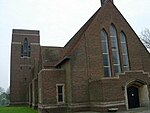Tower Theatre (Folkestone)
FolkestoneFormer churches in KentTheatres in KentUse British English from June 2015

The Tower Theatre is a theatre in Folkestone, Kent that has been converted from the garrison church of Shorncliffe Camp barracks. The venue is owned by Folkestone & Hythe Operatic & Dramatic Society, (FHODS).
Excerpt from the Wikipedia article Tower Theatre (Folkestone) (License: CC BY-SA 3.0, Authors, Images).Tower Theatre (Folkestone)
North Road, Folkestone and Hythe District Shorncliffe Heights
Geographical coordinates (GPS) Address Nearby Places Show on map
Geographical coordinates (GPS)
| Latitude | Longitude |
|---|---|
| N 51.079166666667 ° | E 1.1344444444444 ° |
Address
Shorncliffe Camp
North Road
CT20 3TQ Folkestone and Hythe District, Shorncliffe Heights
England, United Kingdom
Open on Google Maps







